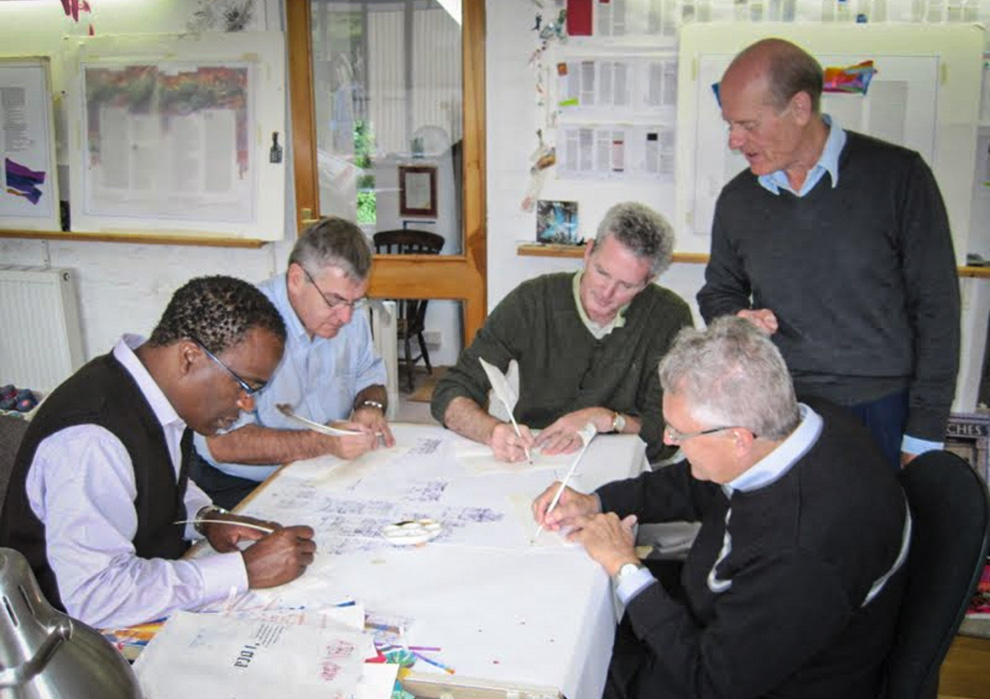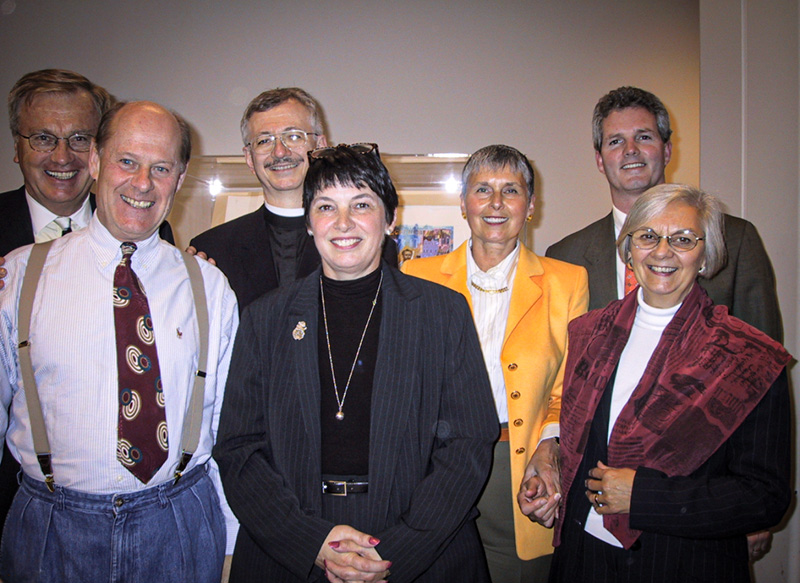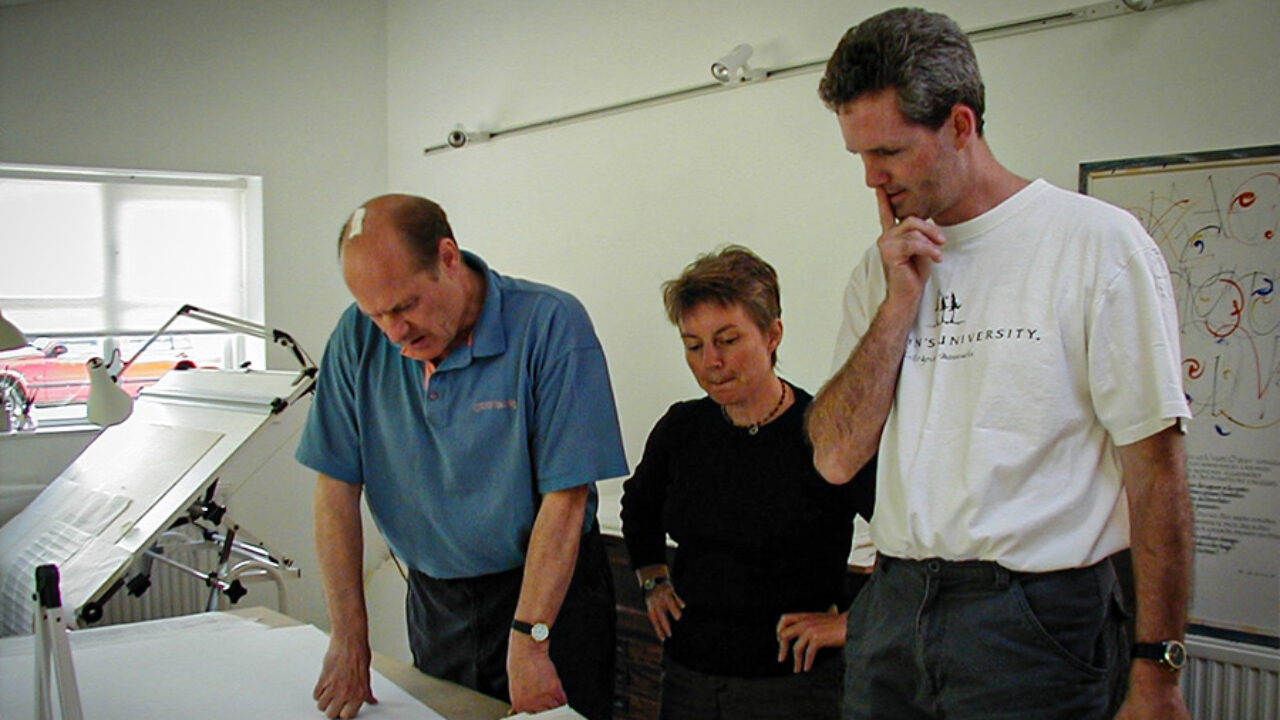Vision, Collaboration, and Legacy: Rob Culligan’s Journey with The Saint John’s Bible
There are very few people who can say they’ve been involved with The Saint John’s Bible since the very beginning. One of those is Fr. Eric Hollas, OSB. Another is Rob Culligan, Vice President for Institutional Advancement at Saint John’s University. He started working on the project when it was a whisper of an idea. Culligan has witnessed the evolution of this monumental spiritual and artistic endeavor over the course of three decades.
Collegeville, Minnesota The year was 1996 and big things were stirring behind the scenes at Saint John’s University and Abbey. The idea was ambitious: to create a contemporary, handwritten, illuminated Bible that would eventually be known as The Saint John’s Bible. For a project as monumental as this one, it was clear from the early stages that a collaboration of the grandest sort was underway.
The vision was set, and the idea for this breathtaking masterpiece was approved. And yet, it would still be another four years before the first words were penned in 2000. While hundreds of people across the world now get to experience The Saint John’s Bible and its facsimiles in full form, there are few people remaining who were involved in those early developmental stages, who breathed life into the project before it had even begun.
Rob Culligan, Vice President for Institutional Advancement at Saint John’s University, remembers those early days well. As a proud Saint John’s alumnus, accepting an invitation to work on the project was an easy “Yes!” and his efforts would ultimately change the course of the entire creation of The Saint John’s Bible in more ways than anyone could have imagined.
“I was the Director of Development at the Hill Museum and Manuscript Library when Br. Dietrich Reinhart and Fr. Eric Hollas asked me and our Advancement team to raise funds for this intriguing project. I was fortunate enough to be at the right place at the right time for the invitation. All these years later, I look back on it saying that this has been a labor of love and a great blessing in my life, both personally and professionally,” said Culligan.
In 1982, Culligan graduated with honors from Saint John’s University with a degree in government. Prior to working for Saint John’s University and the College of Saint Benedict, Culligan was the Executive Director for San Luis Valley Christian Community Services in south central Colorado. He also served as a VIDA volunteer.
Now, for more than 27 years, Culligan has diligently worked for Saint John’s University as Vice President for Institutional Advancement. Outside of his work with The Saint John’s Bible and the University, Culligan also serves on the board of BankVista, an independent community bank in Sartell, Minnesota. He previously served on the Board of the Minnesota Alzheimer’s Association.
“Saint John’s is family to me. I’ve been very fortunate to be able to work here for a long time throughout most of my career. I love the place and I like to say I have the best job in the world. I get to work with alumni and friends who also dearly love the place and it’s a great joy,” said Culligan.
Funding a Bible for the New Millennium
Well before Donald Jackson and his scribes could put quills to vellum, Culligan and his colleagues were asked to figure out how to fund the creation The Saint John’s Bible. How do you convince people to invest in something unseen? To believe in the potential of an art piece that is not yet concrete that may take more than 10 years to complete? Not to mention, embarking on a project of this sort has not been attempted by a Benedictine monastery in more than 500 years.
Not surprisingly, there were skeptics who questioned the wisdom of creating The Saint John’s Bible, especially in an increasingly digital era. Resurrecting an ancient art form and producing a work of sacred art formulated by skilled hands was precisely the point and it was Culligan’s job to help donors see the vision of the project and how it could impact generations to come hundreds of years from now.
“I look back on it now and in those early days, people thought we probably had a screw loose people didn’t understand what we were doing, let alone why,” said Culligan. “During a trip to New York an alumnus asked Br. Dietrich what was new at Saint John’s. When he explained that we were embarking on the first handwritten illuminated Bible in 500 years, the alumnus replied: ‘Maybe there’s a reason no one has attempted to do this in five centuries.’”
“Now, more than 25 years later, it’s been this incredible success, and it has had a transformative impact on people’s lives,” Culligan said. “I’m so glad to have been part of it from the beginning.”
In those early years, the team was working with a rough estimate of the cost to create The Saint John’s Bible. The idea was to approach one donor and ask for a gift to fund it all, and Culligan did just that but there was a catch.
“The first donors made a very generous gift to support The Saint John’s Bible, but it wasn’t the full amount. They told us that this project was far too special, too wonderful, and too important for only one family to support. So instead, they made a challenge gift and told us to go out and find others to support it, and then they would match their gifts,” said Culligan. “Truthfully, that was the best thing they could have ever done because they understood and they knew that The Saint John’s Bible should be something for others to support and enjoy.”

So, Culligan worked with his Saint John’s Advancement colleagues to find more donors. Since that first donation, The Saint John’s Bible has received thousands of gifts from those who believe deeply in the project. Some of these gifts were as small as a dollar, and others were millions of dollars. It was a blessing for those donors in the same way it was a blessing for the team and the project. Not only did these donations help fund the creation of the original manuscript and ensure that some of the greatest calligraphers of our time would be paid for their work, but they also funded exhibition tours, educational and spiritual programs, and the Heritage Program.
The fundraising strategy consisted of a sponsorship program, where donors could sponsor a volume, a book, a page, an illumination, or a verse. One donor even sponsored a letter. As the team well knows, The Saint John’s Bible was never a solitary project it proved itself early on to be a group effort, for everyone and anyone.
“I travel a lot with my job. No matter where I go in the United States or overseas, I always bump into someone who knows about The Saint John’s Bible,” said Culligan. “To witness people far and wide who love this project as dearly as we do at Saint John’s is beyond inspiring and personally rewarding.”
Creating the Heritage Editions and Program
From the inception, the plan was to create one original manuscript that would reside and be on display at Saint John’s University. However, to achieve the goal of inspiring the spiritual imagination of people around the world, the President of Saint John’s University, Brother Dietrich Reinhart, also envisioned spiritual, artistic and education programming, as well as various books and prints and cards that could be experienced by broader audiences. He and others on the team, including Culligan, were asked to reflect on some key questions:
How could it be used in the classroom for teaching and education?
How could it be a source of inspiration and be used in worship around the world?
How can everyone have access to it beyond those in Saint John’s?
How can we organize an exhibition tour so that the public can experience The Saint John’s Bible? How can they see it up close?
These questions launched The Saint John’s Bible project into a new, expansive future, in which the work of sacred art could be held, felt, and enjoyed by people of all faith traditions.
One of the ideas that emerged from these strategic discussions was to create a full-size, fine art limited edition of The Saint John’s Bible. It would later become known as the Heritage Edition. Limited to 299 seven-volume sets, the Heritage Edition is true to the scale, beauty, and artistic intent of the original manuscript.
Not long thereafter, the question arose about how to fund the Heritage Edition, along with a building and gallery to house the original manuscript. Culligan was asked to put together a plan to do so.
“I proposed that we create some customized Benefactor Editions,” said Culligan, “and one of those was limited to 12 sets. So, naturally, I suggested that we call it the Apostles Edition.”

Front Row (LtoR): Donald Jackson, Carol Marrin, Mabel Jackson.
Back Row (LtoR): Jack Hoeschler, Br. Dietrich Reinhart, OSB, Linda Hoeschler; Rob Culligan.
At the same time that a team began work on the creation of these fine art editions of The Saint John’s Bible, another team started working on the plan to promote and sell these works of art to collectors and communities worldwide. Over the years, Culligan has been involved identifying, recruiting, and hiring the leadership team and sales representatives for the Heritage Program.
“The purpose of making the Heritage Editions was to make it more accessible to people worldwide. The most important thing is how many hearts and souls can be touched by The Saint John’s Bible. The mission is to ignite the spiritual imagination of people around the world. That’s the real reason we did this,” said Culligan.
In 2024, years after the completion of the original manuscript, Culligan continues his efforts with the work. Currently, the team is working to conduct research on the different options available for binding the original manuscript of The Saint John’s Bible, which currently remains unbound. For long-term conservation purposes, it is advisable to bind it. Culligan helped raise the funds to support the binding study. He is also part of a group of people who will evaluate and ultimately decide when and how the original manuscript will be bound.
“Our true hope is that the lives of those who see it, read it, reflect on it, and pray over it will be enriched and that they in turn will use their blessings to help others. That’s the true power and significance of The Saint John’s Bible,” said Culligan.
The Saint John’s Bible Heritage Program: Creating and Conserving Spiritual Connection
To read more stories similar to this one, subscribe to the Heritage Program’s monthly e-newsletter, Sharing the Word, or visit the blog.
To follow along with the Heritage Program in real time, follow @SaintJohnsBible on Instagram, Meta, and X.


